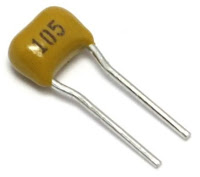Hello friends, ceramic capacitor are widely used in
electronic circuit. But when it comes to know the value of the capacitor it
becomes difficult sometimes, since on ceramic capacitor value is not written
directly. There is a code on the capacitor and you have to decode that code to
know the value.
So how can you know the value of ceramic capacitor? Before
moving ahead get to know some units used in capacitor values.
Unit of capacitor is Farad. But lower value of capacitors are
used in circuits.
First is Pico Farad, 1 pico is equal to 10-12
Second is Nano Farad, 1 nano is equal to 10-9
Third is Micro Farad, 1 micro is equal to 10-6
A ceramic capacitor, usually, have 3 digit code, for example
we have a capacitor having code 105.
First 2 digits (1 & 0) are significant figures, and third
one (5) is multiplier. Multiplier is considered with power of 10 as 105.
After putting all values we have the value in pF (picoFarad)
Pattern of to decode the value
First Figure Second Figure x 10multiplier
Value is in pF
Let’s decode the code
Marking on capacitor ‘105’
Pattern to decode, 10 x 105 = 1000000 pF
Now we have the value in pF, we can change it into nF by
multiplying it by 10-3. Since, It is in pF, which is equal to 10-12 and we are changing it into
nF which is equal to 10-9, difference in these multiplier is of 3.
After multiplying it by 10-3 We have value in nF
= 1000000 x 10-3 nF =1000 nF
But if you want value in micro Farad (μF) then multiply it by 10-6.
= 1000000 x 10-6 μF =1 μF


No comments:
Post a Comment